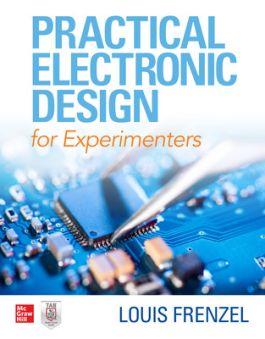Practical Electronic Design for Experimenters
Step 1. Download Adobe Digital Editions Both PC and Mac users will need to download Adobe Digital Editions to access their eBook. You can download Adobe Digital Editions at Adobe's website here.
Step 2. Register an Adobe ID if you do not already have one. (This step is optional, but allows you to open the file on multiple devices) Visit account.Adobe.com to register your Adobe account.
Step 3: Authorize Adobe Digital Editions using your Adobe ID. In Adobe Digital Editions, go to the Help menu. Choose “Authorize Computer.”
Step 4: Open your file with Adobe Digital Editions. Once you’ve linked your Adobe Digital Editions with your Adobe ID, you should be able to access your eBook on any device which supports Adobe Digital Editions and is authorized with your ID. If your eBook does not open in Adobe Digital Editions upon download, please contact customer service
- Introduction
- 1 Introduction to Electronic Design
- Defining Design
- Design Perspective
- Get a Design Notebook
- Get a Calculator
- A Standard Design Approach
- Design Doctrine Dozen
- Types of Design
- Prerequisites for Design
- A Design Example
- An Alternative Beginning
- 2 Design Resources
- Books
- Sources of Catalogs, Components, and Equipment
- Magazines
- Data Sheets
- Applications Notes
- Useful Web Sites
- Educational Sources
- Back to Basics
- Searches
- 3 Simulation and Prototyping
- Circuit Simulation
- Recommendation
- Breadboarding
- Dead Bug Method
- Working with Surface-Mount Components
- Components
- One Good Prototyping Practice
- A Workbench
- Summarizing
- A Word About Tools
- Your Projects
- 4 Testing and Measuring
- Multimeters
- How to Use a Multimeter
- Power Supply
- Oscilloscopes
- Function Generators
- Virtual Instruments
- Circuits for Testing
- Power Supply
- Signal Sources
- Making L and C Measurements
- 5 Common Circuit Design Techniques
- Drawing Circuits
- Series-Dropping Resistor
- Voltage Dividers
- Special Sensor Resistors
- Potentiometers
- Error and Accuracy
- Variable Voltage Dividers
- Transistor Switches
- Design Example 5.1
- Design Example 5.2
- Design Project 5.1
- Design Project 5.2
- Design Project 5.3
- Design Project 5.4
- Design Project 5.5
- 6 Power Supply Design
- Power Supply Choices and Specifications
- The Make vs. Buy Decision
- Common Voltages
- Designing a Battery Supply
- Ampere-Hour Ratings
- Battery Supply Design Procedure
- Battery Supply Enhancements
- Specifying a Linear Supply
- Linear Supply Design Procedure
- Linear Supply Design Example
- Switch-Mode Power Supplies (SMPS)
- Pulse-Width Modulation
- Design Project 6.1
- Design Project 6.2
- Design Project 6.3
- Design Project 6.4
- 7 Amplifier Design
- Amplifier Types
- Specifying Amplifiers
- Understanding the Specifications
- A Microphone Amplifier
- Designing with Op Amps
- Primary Op Amp Application Circuits
- Differential Amplifier
- Error Source Compensation
- Comparators
- Power Amplifiers
- Design Projects
- Design Project 7.1
- Design Project 7.2
- Design Project 7.3
- Design Project 7.4
- 8 Signal Source Design
- Signal Source Specifications
- Sine Wave Oscillators
- Clock Oscillators
- Multivibrators
- Frequency Synthesizers
- Design Project 8.1
- Design Project 8.2
- Design Project 8.3
- Design Project 8.4
- Design Project 8.5
- Design Project 8.6
- 9 Filter Design
- Types of Filters
- Filter Specifications
- Filter Design Guidelines
- Filter Response Options
- RC Filter Design
- Bandpass LC Filters
- Band Reject Filters
- RC Active Filters
- Low-Pass Filter
- LC Filter Design
- Switched Capacitive Filters
- DSP Filters
- Design Project 9.1
- Design Proje
Publisher's Note: Products purchased from Third Party sellers are not guaranteed by the publisher for quality, authenticity, or access to any online entitlements included with the product.
Learn the basics of electronics and start designing and building your own creations!
This follow-up to the bestselling Practical Electronics for Inventors shows hobbyists, makers, and students how to design useful electronic devices from readily available parts, integrated circuits, modules, and subassemblies. Practical Electronic Design for Experimenters gives you the knowledge necessary to develop and construct your own functioning gadgets. The book stresses that the real-world applications of electronics design—from autonomous robots to solar-powered devices—can be fun and far-reaching.
Coverage includes:
- • Design resources
• Prototyping and simulation
• Testing and measuring
• Common circuit design techniques
• Power supply design
• Amplifier design
• Signal source design
• Filter design
• Designing with electromechanical devices
• Digital design
• Programmable logic devices
• Designing with microcontrollers
• Component selection
• Troubleshooting and debugging

